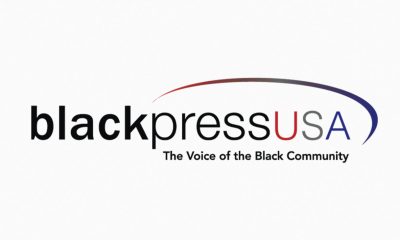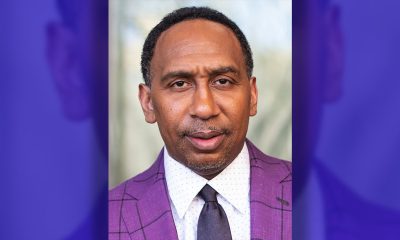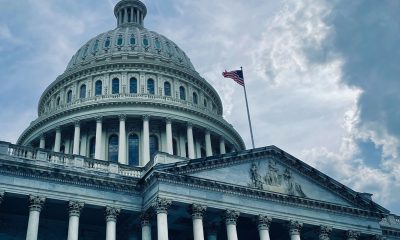Business
Black Business Spotlight: Angie’s Hats
MINNESOTA SPOKESMAN-RECORDER — In the heart of Saint Paul’s art district sits a distinctive shop where milliner Angie Hall Sandifer makes hats.
In the heart of Saint Paul’s art district sits a distinctive shop where milliner Angie Hall Sandifer makes hats. Founded in 2006, her namesake brand Angie’s Hats has grown from a class project after getting laid off to an international business, supplying custom-fitted creations to hat lovers all over the world.
Her hats are flashy, extravagant, and one-of-a-kind. They speak to the rich traditions of Black women and their coveted church hats as well as women all over the world clamoring for crowning looks at the Kentucky Derby.
We caught up with Sandifer in her sixth-floor Lowertown studio filled with hats and millinery equipment to talk inspiration, the creation process, and her vision for the future.
MSR: How did you learn how to make hats?
Angie Hall Sandifer: There was nobody [locally] to teach me, so someone recommended that I work at the Guthrie in the costume department. [Then] I ended up finding a master milliner in North Carolina. I had private lessons with her, [but] when I came back, I was [still] clueless. I kept practicing and one day some real hats started showing up!
MSR: How did a class project inspire your business?
AHS: I grew up in the South and I was a Baptist. My mother wore hats, my grandmother wore hats, my father wore caps. He liked seeing us in hats, so that whole church hat thing was an inspiration for me. I love hats, I never thought I would be making them, but it worked out and I found my passion.
MSR: What kind of hats do you make?
AHS: I started out with just basic hats — mostly church hat styles. But, as the years went by, I’ve gotten a little bit more creative. Now I do Kentucky Derby hats, as well.
MSR: The Kentucky Derby is in May. How long does it take to make a hat?
AHS: Probably a week, at most.
MSR: That’s pretty intense. What’s the process like?
AHS: There are different ways to make hats. Sometimes I use fabric, sometimes it’s straw, etc… I make them the old-fashioned way — wood blocks, steam, wire, those sorts of things. A lot of people think that you just buy a mold and add things, but that’s not how I do it.

Angie’s Hats celebrate Black style history (Submitted photo)
You come in for a fitting [and] you find different embellishments, such as ribbon or feathers, and I make the hat. Then you come in for a second fitting to find out if I need to make any adjustments. It’s custom-made to fit your head.
MSR: Do you make men’s hats?
AHS: I make fedora-style hats.
MSR: Where do you draw your inspiration?
AHS: Old movies. I just love that era when people got dressed up. They were elegant, they were classy, so that’s kind of my inspiration.
MSR: What’s your vision for Angie’s Hats?
AHS: I want to do more shows. I want to get more involved in conferences that come to the Twin Cities and become a vendor. My goal is to have [my hats] in boutiques and not sell them online.
MSR: Why not online?
AHS: A lot of times we find hats online that are pretty and we order them. [We get them and] they don’t look good on us or they don’t fit [well] because a lot of people don’t know what their head size is. So they send them back. I don’t want to get into shipping orders. I just want to make hats and sell them locally or in boutiques across the country.
MSR: Who is your clientele?
AHS: I sell church hats to a lot of women going to weddings in Europe because hats are customary there. But my busy season is the Kentucky Derby.
MSR: How do you interact with the art community around you in Lowertown and the Twin Cities?
AHS: I’ve been a part of the art crawl, and I usually open my studio for it. People are a little bit surprised to see hats, and people are really receptive.
MSR: What has been the most rewarding part of owning your business?
AHS: I used to work with kids through Big Brothers, Big Sisters, and I always used to tell the kids, “The only career advice you need is to find your passion and follow it.” But I never thought I’d find my passion — and I did.
Angie’s Hats is located at 308 Prince Street, Studio 610 in St. Paul. The shop is open by appointment only. For more info, call 651-208-4442 or visit angieshats.com.
This article originally appeared in the Minnesota Spokesman-Recorder.
Alameda County
Seth Curry Makes Impressive Debut with the Golden State Warriors
Seth looked comfortable in his new uniform, seamlessly fitting into the Warriors’ offensive and defensive system. He finished the night with an impressive 14 points, becoming one of the team’s top scorers for the game. Seth’s points came in a variety of ways – floaters, spot-up three-pointers, mid-range jumpers, and a handful of aggressive drives that kept the Oklahoma City Thunder defense on its heels.

By Y’Anad Burrell
Tuesday night was anything but ordinary for fans in San Francisco as Seth Curry made his highly anticipated debut as a new member of the Golden State Warriors. Seth didn’t disappoint, delivering a performance that not only showcased his scoring ability but also demonstrated his added value to the team.
At 35, the 12-year NBA veteran on Monday signed a contract to play with the Warriors for the rest of the season.
Seth looked comfortable in his new uniform, seamlessly fitting into the Warriors’ offensive and defensive system. He finished the night with an impressive 14 points, becoming one of the team’s top scorers for the game. Seth’s points came in a variety of ways – floaters, spot-up three-pointers, mid-range jumpers, and a handful of aggressive drives that kept the Oklahoma City Thunder defense on its heels.
One of the most memorable moments of the evening came before Seth even scored his first points. As he checked into the game, the Chase Center erupted into applause, with fans rising to their feet to give the newest Warrior a standing ovation.
The crowd’s reaction was a testament not only to Seth’s reputation as a sharpshooter but also to the excitement he brings to the Warriors. It was clear that fans quickly embraced Seth as one of their own, eager to see what he could bring to the team’s championship aspirations.
Warriors’ superstar Steph Curry – Seth’s brother – did not play due to an injury. One could only imagine what it would be like if the Curry brothers were on the court together. Magic in the making.
Seth’s debut proved to be a turning point for the Warriors. Not only did he contribute on the scoreboard, but he also brought a sense of confidence and composure to the floor.
While their loss last night, OKC 124 – GSW 112, Seth’s impact was a game-changer and there’s more yet to come. Beyond statistics, it was clear that Seth’s presence elevated the team’s performance, giving the Warriors a new force as they look to make a deep playoff run.
Activism
Oakland Post: Week of November 26 – December 2, 2025
The printed Weekly Edition of the Oakland Post: Week of November 26 – December 2, 2025

To enlarge your view of this issue, use the slider, magnifying glass icon or full page icon in the lower right corner of the browser window.
Activism
Oakland Post: Week of November 19 – 25, 2025
The printed Weekly Edition of the Oakland Post: Week of November 19 – 25, 2025
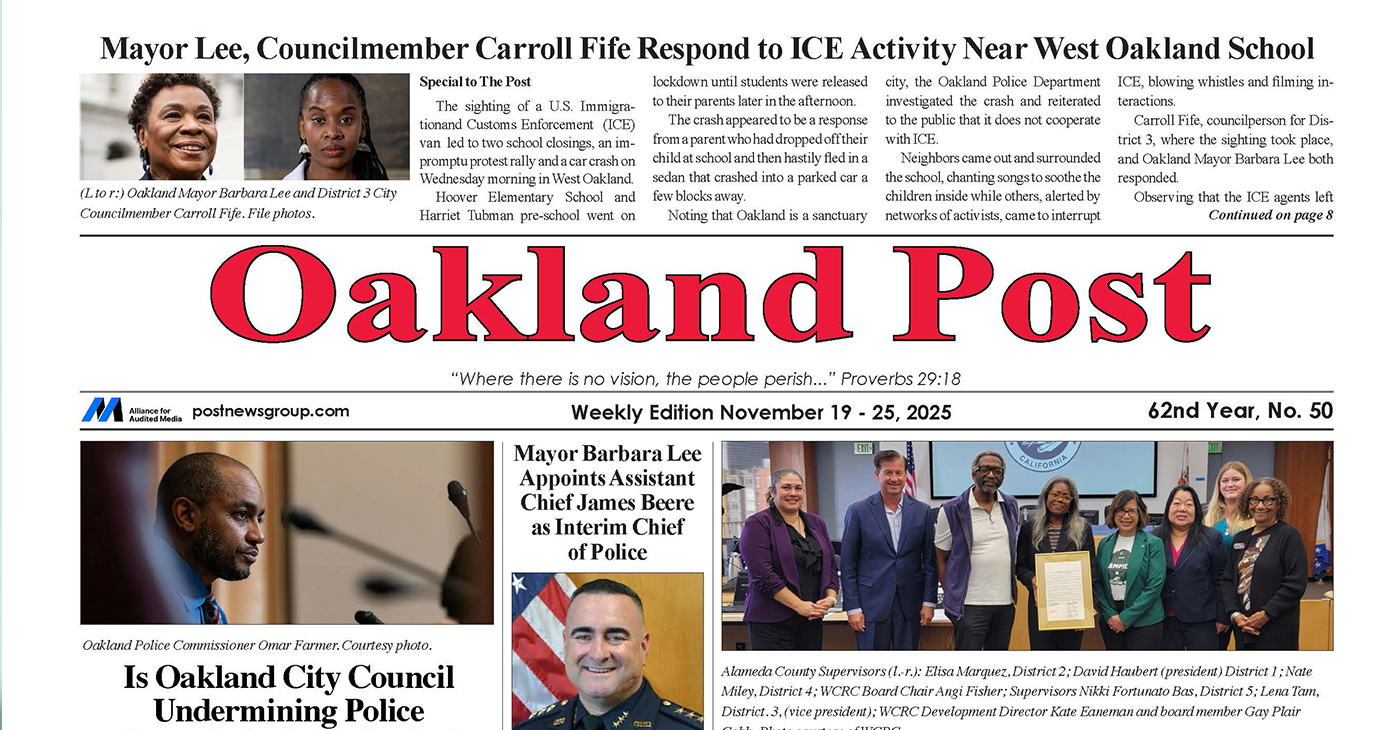
To enlarge your view of this issue, use the slider, magnifying glass icon or full page icon in the lower right corner of the browser window.
-

 Activism3 weeks ago
Activism3 weeks agoOakland Post: Week of November 12 – 18, 2025
-
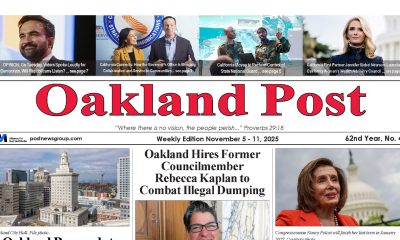
 Activism4 weeks ago
Activism4 weeks agoOakland Post: Week of November 5 – 11, 2025
-

 Activism2 weeks ago
Activism2 weeks agoIN MEMORIAM: William ‘Bill’ Patterson, 94
-

 Activism3 weeks ago
Activism3 weeks agoHow Charles R. Drew University Navigated More Than $20 Million in Fed Cuts – Still Prioritizing Students and Community Health
-

 Bay Area3 weeks ago
Bay Area3 weeks agoNo Justice in the Justice System
-

 #NNPA BlackPress3 weeks ago
#NNPA BlackPress3 weeks agoThe Perfumed Hand of Hypocrisy: Trump Hosted Former Terror Suspect While America Condemns a Muslim Mayor
-
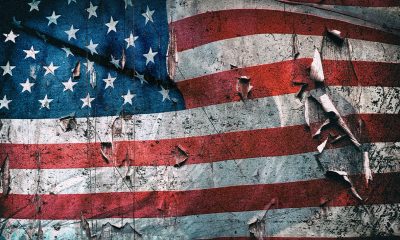
 #NNPA BlackPress2 weeks ago
#NNPA BlackPress2 weeks agoTrump’s Death Threat Rhetoric Sends Nation into Crisis
-

 #NNPA BlackPress4 weeks ago
#NNPA BlackPress4 weeks agoProtecting Pedophiles: The GOP’s Warped Crusade Against Its Own Lies



